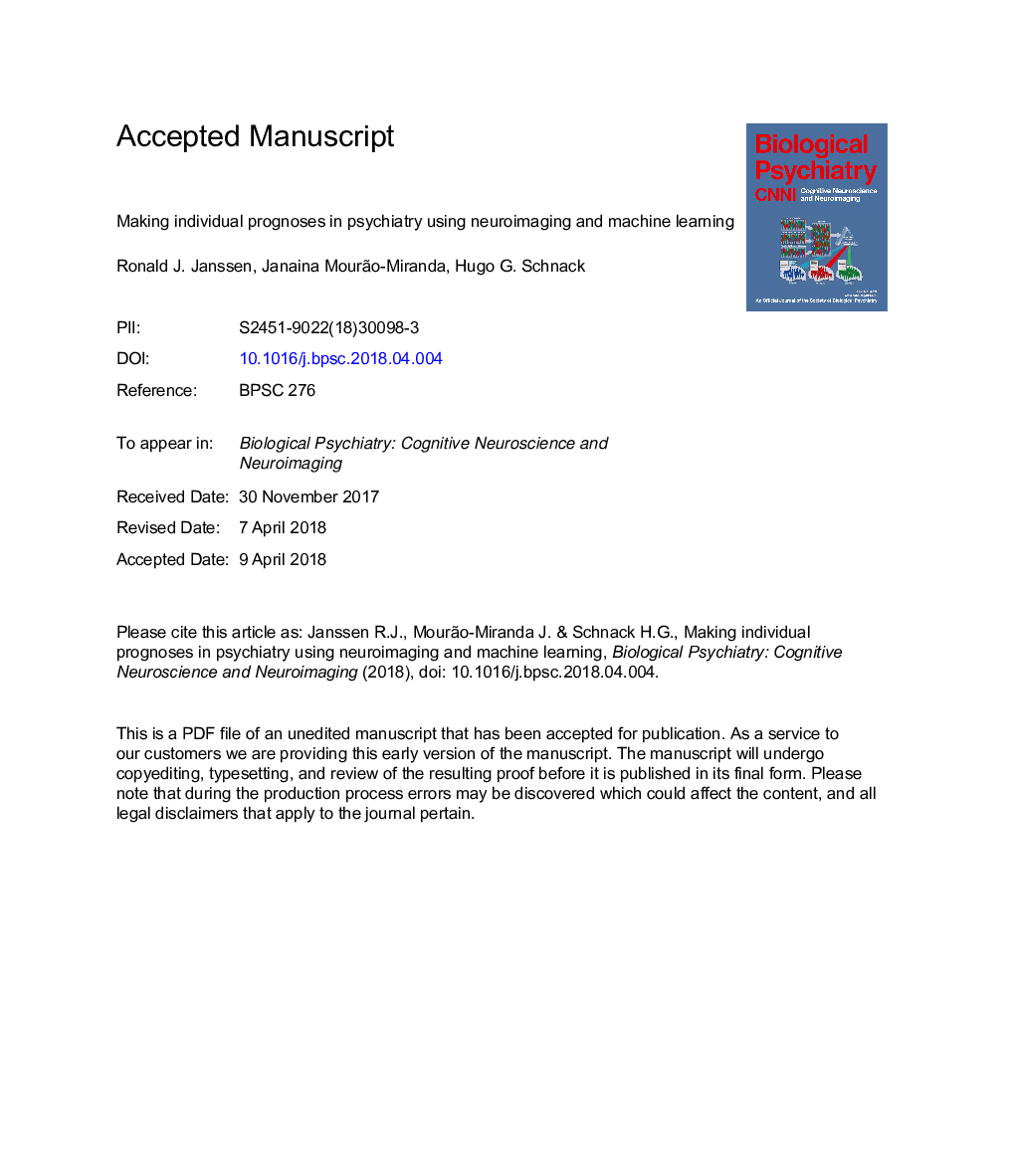| کد مقاله | کد نشریه | سال انتشار | مقاله انگلیسی | نسخه تمام متن |
|---|---|---|---|---|
| 8959069 | 1646287 | 2018 | 50 صفحه PDF | دانلود رایگان |
عنوان انگلیسی مقاله ISI
Making Individual Prognoses in Psychiatry Using Neuroimaging and Machine Learning
ترجمه فارسی عنوان
پیش بینی های فردی در روانپزشکی با استفاده از تصویر برداری عصبی و یادگیری ماشین
دانلود مقاله + سفارش ترجمه
دانلود مقاله ISI انگلیسی
رایگان برای ایرانیان
کلمات کلیدی
تصویربرداری، فراگیری ماشین، اختلال افسردگی عمده، پیش بینی، پیش بینی، جنون جوانی،
ترجمه چکیده
پیش آگهی روانپزشکی یک مشکل دشوار است. تهیه پیش آگهی نیازمند نگاه کردن به آینده در آینده است، به غیر از تشخیص، که مربوط به وضعیت فعلی است. در طول دوره پیگیری، بسیاری از عوامل بر روند بیماری تأثیر می گذارند. این امر با پیش بینی های پیش آگهی همراه با داده های طولی و معمولا متغیر در تعریف نتایج / تحولات یک تلاش چالش انگیز است. استفاده از داده های تصویر برداری عصبی در این تلاش، مانع اضافی ابعاد بزرگ را معرفی می کند. تکنیک های یادگیری ماشین مخصوصا برای مقابله با این مشکل چالش برانگیز هستند. این بررسی با معرفی مختصر به یادگیری ماشین در زمینه استفاده از داده های بالینی عصبی آغاز می شود. ما چند مسأله را که مخصوصا برای پیش بینی نتایج و انتقال با استفاده از تصویر برداری عصبی هستند، برجسته می کنیم. ما سپس ادبیات را که در مورد کاربرد یادگیری ماشین برای این منظور بحث می کنیم، بررسی می کنیم. بررسی بحرانی مطالعات و نتایج آنها با توجه به مسائل مربوط به موارد زیر نشان داد: 1) شواهد رو به رشدی برای قابلیت پیش آگهی مدل مبتنی بر یادگیری ماشین با استفاده از تصویربرداری عصبی وجود دارد؛ و 2) تطابق گزارش شده ممکن است به دلیل حجم نمونه های کوچک و عدم نمونه های آزمایشی مستقل، بسیار خوش بین باشد. در نهایت، ما گزینه هایی برای بهبود قابلیت اطمینان (پیش بینی) مدل های پیش بینی را مورد بحث قرار می دهیم. این شامل روش های جدید و مدل سازی چندجمله ای است. با این حال، ما بر این باوریم که نتیجه گیری ما این است که کار آینده نیاز به ارزیابی دقیق (متقابل) اعتبار سنجی دقیق از مدل های آموزش داده شده بر روی مجموعه داده های به اندازه کافی خواهد داشت. با این وجود، با پیشرفت های تکنولوژیکی که می توان پایگاه های داده های بزرگ بیماران و افراد سالم را به وجود آورد، یادگیری ماشین نشان دهنده یک ابزار قدرتمند در جستجو برای نشانگرهای روان پزشکی است.
موضوعات مرتبط
علوم زیستی و بیوفناوری
علم عصب شناسی
روانپزشکی بیولوژیکی
چکیده انگلیسی
Psychiatric prognosis is a difficult problem. Making a prognosis requires looking far into the future, as opposed to making a diagnosis, which is concerned with the current state. During the follow-up period, many factors will influence the course of the disease. Combined with the usually scarcer longitudinal data and the variability in the definition of outcomes/transition, this makes prognostic predictions a challenging endeavor. Employing neuroimaging data in this endeavor introduces the additional hurdle of high dimensionality. Machine learning techniques are especially suited to tackle this challenging problem. This review starts with a brief introduction to machine learning in the context of its application to clinical neuroimaging data. We highlight a few issues that are especially relevant for prediction of outcome and transition using neuroimaging. We then review the literature that discusses the application of machine learning for this purpose. Critical examination of the studies and their results with respect to the relevant issues revealed the following: 1) there is growing evidence for the prognostic capability of machine learning-based models using neuroimaging; and 2) reported accuracies may be too optimistic owing to small sample sizes and the lack of independent test samples. Finally, we discuss options to improve the reliability of (prognostic) prediction models. These include new methodologies and multimodal modeling. Paramount, however, is our conclusion that future work will need to provide properly (cross-)validated accuracy estimates of models trained on sufficiently large datasets. Nevertheless, with the technological advances enabling acquisition of large databases of patients and healthy subjects, machine learning represents a powerful tool in the search for psychiatric biomarkers.
ناشر
Database: Elsevier - ScienceDirect (ساینس دایرکت)
Journal: Biological Psychiatry: Cognitive Neuroscience and Neuroimaging - Volume 3, Issue 9, September 2018, Pages 798-808
Journal: Biological Psychiatry: Cognitive Neuroscience and Neuroimaging - Volume 3, Issue 9, September 2018, Pages 798-808
نویسندگان
Ronald J. Janssen, Janaina Mourão-Miranda, Hugo G. Schnack,
